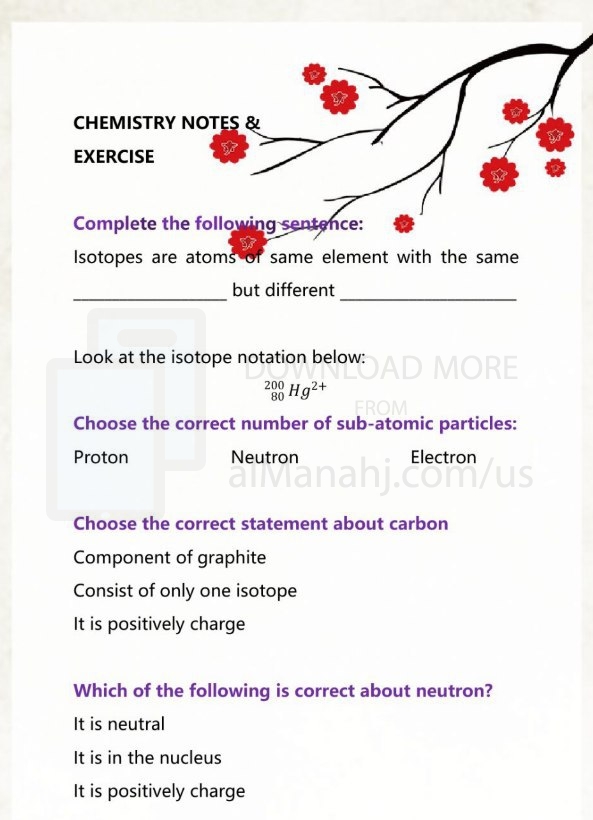| You are here: Almanahj Website ⇒ American curriculum ⇒ 12th Grade ⇒ Chemistry ⇒ Term 1 | ||
|---|---|---|
Worksheet about chemistry isotopes | ||
|---|---|---|
| Subject: Chemistry | ||
| 12th Grade | ||
| Term 1 | ||
| Year: 2023/2024 | ||
| Size: 320.4KB | ||
| Number of clicks: 182 | ||
| Publish date:November 06, 2023 | ||
| Added by: Eman | ||
| Last download date: 2024-08-28 08:12:19 | ||
| Updated by: Eman9966 on 2023-11-06 05:29:25 | By: theodor NURUL HIDAYAH KAMARDIN | |
| File info: Chemistry isotopes refer to different forms of an element that have the same number of protons but varying numbers of neutrons in their atomic nuclei. Here is a description of chemistry isotopes: Isotopes are atoms of the same element that differ in their atomic mass due to the different number of neutrons in their nuclei. While the number of protons determines the element's identity, isotopes have different mass numbers due to the varying number of neutrons. For example, carbon has three naturally occurring isotopes: carbon-12, carbon-13, and carbon-14. Carbon-12 has 6 protons and 6 neutrons, carbon-13 has 6 protons and 7 neutrons, and carbon-14 has 6 protons and 8 neutrons. These isotopes have the same number of protons, indicating that they are all carbon atoms, but their different numbers of neutrons contribute to their different atomic masses. Isotopes can be stable or unstable. Stable isotopes do not undergo spontaneous radioactive decay, while unstable isotopes, known as radioactive isotopes or radioisotopes, do decay over time. Radioactive decay involves the release of particles and/or energy from the nucleus as the unstable isotope transforms into a different element or a different isotope of the same element. Isotopes have various applications in chemistry and other scientific fields. Some of these applications include:1. Radiometric Dating: Radioisotopes with known decay rates, such as carbon-14, are used to determine the age of fossils, artifacts, and geological materials. 2. Nuclear Medicine: Radioisotopes are used in medical imaging and treatments, such as positron emission tomography (PET) scans and radiation therapy. 3. Tracers and Labeling: Isotopes can be used as tracers to track the movement of substances in chemical reactions or biological systems. For example, isotopes of hydrogen (deuterium and tritium) are often used as tracers in scientific research. 4. Isotopic Analysis: Isotopic composition analysis is used to study the origin, migration, and reactions of substances in various fields, including environmental science, geology, and forensic science. 5. Nuclear Power: Certain isotopes, such as uranium-235 and plutonium-239, are used as fuel in nuclear reactors to generate electricity. Studying isotopes provides valuable insights into the behavior and properties of elements. By examining isotopic ratios and variations, scientists can investigate processes like elemental cycling, environmental changes, and the history of Earth and the universe. Overall, chemistry isotopes play a crucial role in understanding the nature of matter, enabling researchers to explore diverse areas of science and apply this knowledge in practical applications. | ||
| Downloading link Worksheet about chemistry isotopes |
|---|
|
1699248523.pdf
The file is being prepared for download
|
| File images |
|---|
 |